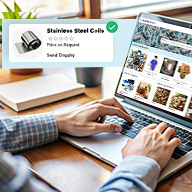To succeed as an SME, be your authentic self

Learning & Development
322 week ago — 6 min read
As a founder, of course you want to develop and offer the very best product or service possible. In fact, you are probably striving for perfection, utilising all of the tips, tools and resources available to you in order to achieve that goal.
Few of us ever actually achieve total perfection, but the good news is we don’t necessarily need to. In fact, your customers might like you even more in a slightly imperfect state—that is, as long as you are authentic.
Digital Marketing is Eroding Traditional Models of Promotion
Once you have created the very best product you can, you need to think about promoting it, in a way that persuades people to buy it.
As explained in Marketing in a Digital World with Aric Rindfleisch, one of the many courses available from GlobalLinker affiliate partner, Coursera, the old approach to promotion was known as “top down,” devoted heavily to firm-controlled advertising and entailing very little customer involvement or consultation. But, as Rindfleisch explains, “In this new digital marketing environment we are moving from managed messages designed to persuade to authentic messages designed to narrate or tell a story.”
A firm’s customers are now sometimes heavily involved in the promotion process. In fact, they may not only help you to distribute your ads, and to promote your product and messages but, as explained in the GlobalLinker article, “Perfecting your Product – Without a huge product development team,” they may even help you to create those things in the first place.
Your customers’ social media commentary can be hugely impactful to your firm, at least helping to make or break it, long after their actual purchase of a product is complete. If they decide that they love you, their loyalty and creativity can know no bounds. But if you betray or disappoint your customers, both your revenue and reputation may be at risk.
So what is authenticity? How to achieve it?
Let’s start with what authenticity isn’t. As the Marketing in a Digital World course explains in much greater detail, there are two key factors that make brands seem inauthentic:
- Imitation – when a firm seems to be copying or “knocking off” another firm
- Mismatch – when the image the firm is trying to project clearly doesn’t match the reality of the situation
The course also offers several tips on how to achieve authenticity, thereby increasing your odds of succeeding as a small or medium enterprise:
- First, be yourself. Marketing in a Digital World quotes American actress Judy Garland as saying, “Be a first-rate version of yourself, not a second-grade version of someone else.” This includes being true to your company’s “heritage” and “current reality.”
- Be truthful. Firms often stretch the truth, at least slightly, when promoting their products. But, with online research resources easily available these days, this becomes all the more risky. As the Coursera course explains, “a growing number of firms are realizing that presenting themselves and their products in a genuine [way] is simply good business practice in a digital age.” This refers, the course adds, “to the degree to which a product's online promotion provides customers with a genuine portrayal of its origins, features, and benefits, as well as its limitations.”
- Be consistent. Your customers will grow suspicious if your firm is different things to different people and on different platforms. “Once a firm tells its authentic story, it needs to stick with its story, even if it seems unpopular at times,” the course stresses.
- Admit your mistakes. Marketing in a Digital World offers the example of Dominos Pizza, which shared with its customers that it was trying to improve its recipe. They then featured real customers trying the new and improved product and loving it. Of course, this kind of thing need to be done carefully and with the same strategy and skill that one might approach a traditional advertising campaign—simply sharing your flaws won’t automatically lead customers to embrace you. But, as the Marketing in Digital World course notes, “Firms that don’t admit their mistakes are most likely to have this mistake made public by someone else. If that occurs, this mistake becomes much more embarrassing and more costly in the long run.”
- Instead of selling, try telling a story. This story doesn’t even necessarily have to be completely flattering, but it does have to be appealing and to resonate in a human way. And if someone must sell your product, the Coursera course adds, perhaps it should be your customers, not your company. Claims about your product can be more objectively trusted if they come from actual users, via testimonials. You might even consider featuring customers in your ads instead of paid actors. (The course sites a successful Patagonia campaign, in which customers tell stories and submit photos and videos about how they use the company’s products.) As described in this previous GlobalLinker article, “Perfecting your Product – Without a huge product development team, there are numerous ways to inspire your customers to contribute the kind of content.
In sum, authenticity alone won’t get you where you need to be. You will still need a strong product, and your promotions will still need to be thoughtful and strategic, connecting with your customers and what matters to them. It can take a bit of practice, and various approaches and adjustments. But if you keep these basic principles in mind, and continue to learn more about Marketing in a Digital World, you should have a better chance of getting there.
Posted by
GlobalLinker StaffWe are a team of experienced industry professionals committed to sharing our knowledge and skills with small & medium enterprises.
Network with SMEs mentioned in this article
View GlobalLinker 's profile
Most read this week
Trending
What is the Curse of Knowledge? How Does it Impact Communication?
Learning & Development 12 week ago
Learning & Development 50 week ago













Comments (2)
Share this content
Please login or Register to join the discussion